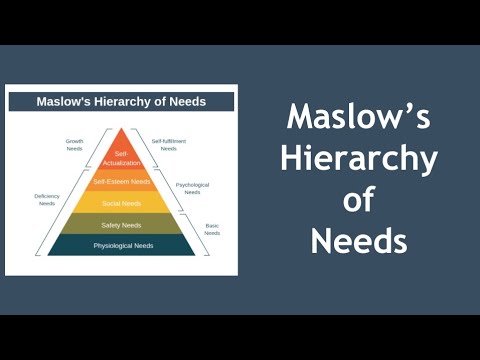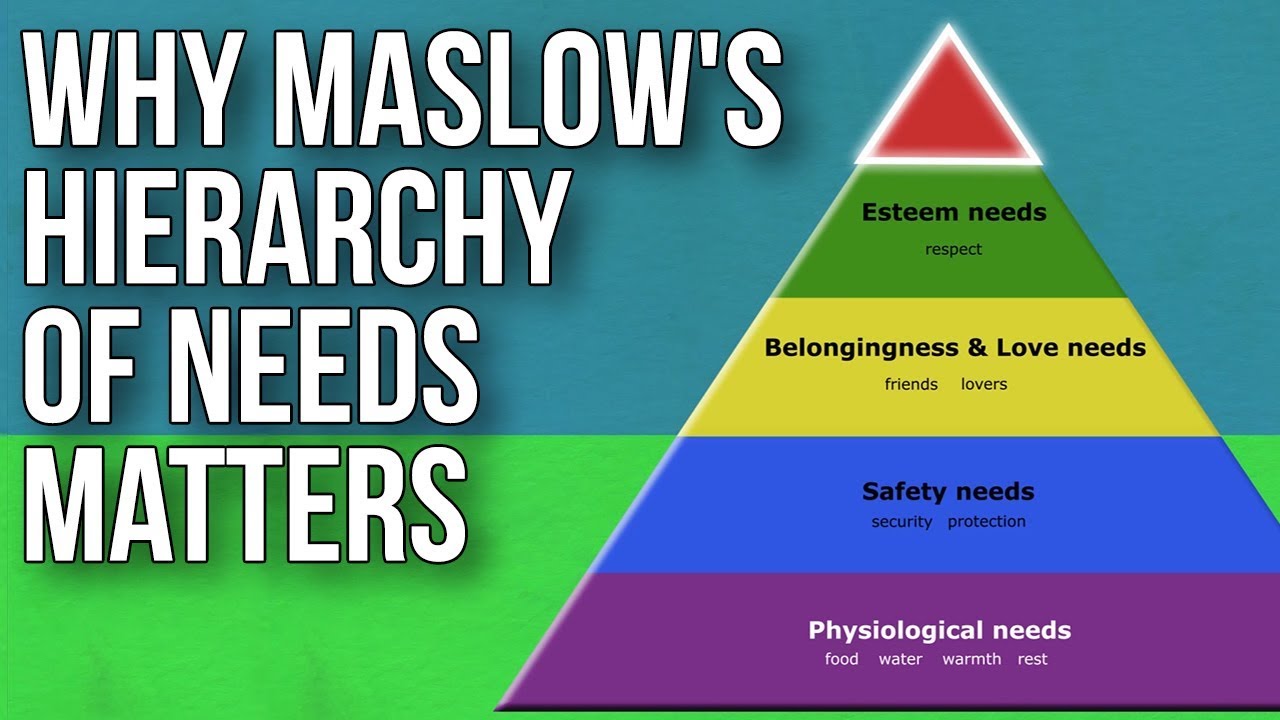Maslow's Hierarchy of Needs
Major Concept Summary: Maslow’s Hierarchy of Needs
Ed 304: Psych and Human Development
Author: Sophie Hansen
Verified By: April Greenwood, Tegan Ross, Isabelle Roberts, Molly Fairbanks 1/18/23, Madison Giles 1/25/23, Macey Mattson 1/25/2023
Disclosure: ChatGPT was used in the creation of this resource
Summary
Maslow's hierarchy of needs is a theory in psychology that proposes that human beings have a certain set of needs that must be met for them to achieve self-actualization. The theory is broken down into five levels, each of which is considered more important than the one before it. The five levels are physiological needs, safety needs, belongingness and love needs, esteem needs, and self-actualization needs.
Vocabulary
Hierarchy of needs: a theory proposed by Abraham Maslow that explains the different levels of needs that people have, in order of priority
Physiological needs: the basic needs that must be met to survive, such as food, shelter, and clothing
Safety needs: the need for protection from physical and emotional harm, including stability, security, and protection from danger
Belonging and love needs: the need for companionship, affection, and a sense of belonging
Esteem needs: the need for self-esteem, self-respect, and the respect of others
Self-actualization: the realization of one's full potential and the pursuit of personal growth and fulfillment
Motivation: the driving force that causes people to act and pursue certain goals
Personal growth: the process of developing and improving oneself
Self-esteem: confidence and respect in oneself
Self-actualizing individuals: people who have fulfilled their needs and have reached the highest level of personal growth, self-actualization
Self-transcendence: individual goes beyond their self-interests to help others or the greater good
Hierarchy of Motives: the theory that human behavior is motivated by a series of needs, arranged in a hierarchical order, which must be fulfilled in a specific sequence
Cognitive Dissonance: state of mental discomfort or tension that arises when an individual holds two or more contradictory beliefs or values
Here is an example of each one of the needs:
- Physiological needs: An example of meeting physiological needs would be providing food and water to a person who is experiencing homelessness.
- Safety needs: An example of meeting safety needs would be providing a safe and secure home for a person who has experienced domestic violence.
- Belongingness and love needs: An example of meeting belongingness and love needs would be fostering a sense of community and connection through a support group for people dealing with a similar issue.
- Esteem needs: An example of meeting esteem needs would be providing opportunities for personal and professional development, such as job training or educational classes, to help a person improve their self-esteem and self-worth.
- Self-actualization needs: An example of meeting self-actualization needs would be encouraging an individual to pursue their passions and hobbies, like writing or painting, to help them achieve self-actualization and reach their full potential.
In education, it can be used to understand the needs of students and to create educational programs that meet those needs. It can be used to help educators understand the different levels of needs that students have and to create an educational environment that meets those needs.
Criticisms
- The hierarchy is too simplistic and does not take into account the complexity of human motivation.
- The hierarchy suggests that all individuals will go through the same stages in the same order, which is not accurate.
- The hierarchy does not account for cultural or societal differences in motivation and needs.
- The hierarchy has been criticized for being overly individualistic and not considering the impact of societal and environmental factors on motivation.
- Research has shown that people do not always prioritize their needs in the order presented in the hierarchy.
Media Examples


Abraham Maslow
Abraham Maslow was an American psychologist and philosopher who is best known for his theory of human motivation, commonly referred to as Maslow's Hierarchy of Needs. Born on April 1, 1908, in Brooklyn, New York, Maslow was the eldest of seven children in a Jewish immigrant family. Growing up, he was a quiet and introverted child who struggled in school due to his poor eyesight. Despite these challenges, he was determined to succeed and eventually went on to earn a Bachelor's degree in psychology from the City College of New York and a Master's degree from the University of Wisconsin-Madison.
After completing his education, Maslow began his career as a researcher and lecturer at Brooklyn College. It was during this time that he began to develop his theory of human motivation, which he believed was based on the idea that people are driven by a hierarchy of needs. According to Maslow, these needs include physiological needs, safety needs, belongingness and love needs, esteem needs, and self-actualization needs. He believed that as individuals meet their lower-level needs, they become motivated to meet their higher-level needs, ultimately leading to self-actualization or the fulfillment of one's potential.
Maslow's theory of human motivation was met with both criticism and praise, with many in the field of psychology praising its simplicity and practicality. In addition to his work on motivation, Maslow also made significant contributions to the field of humanistic psychology, which emphasizes the importance of self-actualization and the individual's subjective experience. He was also a strong advocate for the use of self-help techniques to improve mental health, which he believed was essential to achieving self-actualization.
Throughout his career, Maslow published several books and articles, including "Motivation and Personality" (1954), "Toward a Psychology of Being" (1962), and "The Farther Reaches of Human Nature" (1971). He also served as a professor at Brandeis University and the University of California, Berkeley, before eventually retiring in 1974. He died of a heart attack on June 8, 1970, at the age of 62.
Abraham Maslow was a pioneering psychologist and philosopher who made significant contributions to the field of human motivation and humanistic psychology. His theory of human motivation, known as Maslow's Hierarchy of Needs, continues to be widely studied and has had a profound impact on the field of psychology and the way we understand human behavior. His work has also had a significant impact on the field of self-help and has helped many people to understand and improve their own lives. Maslow's legacy continues to live on through his writings and the many people whose lives have been touched by his work.
Teacher Connections
Maslow’s hierarchy can be used by teachers in a variety of ways:
- Understanding student needs: help teachers to understand the underlying needs of their students, which can play a critical role in their motivation and behavior
- Building relationships: help teachers to build positive relationships with their students and create a supportive classroom environment
- Fostering self-esteem: Understand how to foster self-esteem and a sense of self-worth in their students, which is essential for success in school and life.
- Encouraging self-actualization: Teachers can help their students to reach their full potential and achieve their goals.
- Differentiation: Differentiate instruction and adapt the curriculum to meet the needs of different students with different needs.
- Planning: Plan and design their lessons and activities in a way that addresses the needs of all students.
- Feedback: Provide feedback that is constructive and helps students to improve their skills and achieve their goals.
- Creating a positive learning environment: Create a positive learning environment that meets the needs of all students and supports their growth and development.
- Enhancing student motivation: By understanding the different needs in Maslow's Hierarchy, teachers can better understand how to motivate their students and create an environment that supports their growth and development.
Possible Teacher Activities
Goal-setting: Teachers can help students to set goals based on their needs and how they align with Maslow's Hierarchy. For example, students can set goals for meeting their physiological needs, safety needs, belongingness and love needs, esteem needs, and self-actualization needs.
Journaling: Teachers can have students journal about their needs and how they align with Maslow's Hierarchy. This can help students to reflect on their own needs and how they can be met.
Creative Writing: Teachers can have students write a story, poem, or song that aligns with Maslow's Hierarchy of Needs. This can help students to better understand how the needs align in real-life scenarios.
Ask the Teacher
High school psychology teacher Robert McPherson says that Maslow’s hierarchy is “incredibly useful in the classroom,” because it helps the teacher understand the underlying needs of the students.
“I use Maslow's Hierarchy in building positive relationships with my students and creating a supportive classroom environment. I prioritize building a sense of belonging and love among my students, which I believe is crucial for their success in school. Additionally, I work to foster self-esteem and a sense of self-worth in my students, which is essential for their success in school and life.”
McPherson feels it is important to “create an environment that supports their growth and development.” By using Maslow’s hierarchy, he can determine that the student's needs are met before he can focus on learning. By understanding each student's needs, McPherson can help their learning become more successful in the classroom.
Quiz Questions
- Which of the following best describes Maslow's hierarchy of needs?
- A theory th at suggests that all human needs can be divided into five categories, with physiological needs being the most basic and self-actualization needs being the most complex.
- A framework that suggests that all human needs are interconnected and must be met simultaneously to achieve overall well-being.
- A model that proposes that individuals must first meet their basic physiological needs before they can progress to higher levels of needs, such as safety and security.
- A principle that states that people have a natural inclination to pursue self-actualization, but are held back by lower-level needs, such as esteem and belongingness
- Which of the following best describes a person's behavior when they are primarily motivated by self-actualization, according to Maslow's hierarchy of needs?
- They are constantly seeking new challenges and experiences to push themselves to their limits
- They prioritize their physical needs, such as food and shelter, above all else.
- They are preoccupied with maintaining social relationships and belonging to a group
- They are focused on achieving status and power within their community
- True or False: A person who has fulfilled their physiological needs, such as food and shelter, but has not yet fulfilled their safety needs, such as feeling secure in their environment, will prioritize fulfilling their safety needs over their social needs, such as forming relationships and belonging to a community.
- True
- False
- If an individual is experiencing financial hardship and is unable to afford necessities such as food and shelter, they will likely be focused on fulfilling their physiological needs before moving on to the next level of Maslow's hierarchy, which is ____________.
- Love/belonging
- Safety
- Physiological
- Esteem
- Which level of Maslow's Hierarchy of Needs is being addressed when an individual is seeking to improve their self-esteem and self-worth?
- Physiological Needs
- Safety and Security Needs
- Belonging and Love Needs
- Esteem Needs
- Self-Actualization Needs
References and Further Readings:
https://www.masterclass.com/articles/a-guide-to-the-5-levels-of-maslows-hierarchy-of-needs
https://www.thoughtco.com/maslows-hierarchy-of-needs-4582571
https://www.verywellmind.com/what-is-maslows-hierarchy-of-needs-4136760
This content is provided to you freely by BYU-I Books.
Access it online or download it at https://books.byui.edu/development_motivati/KISmNXvB.



